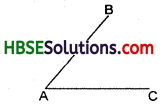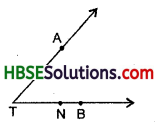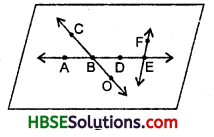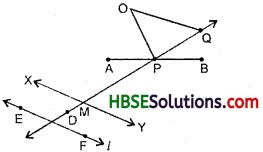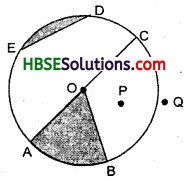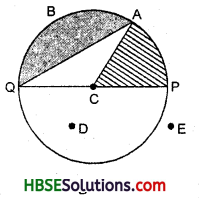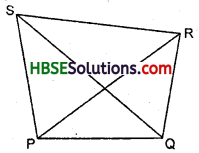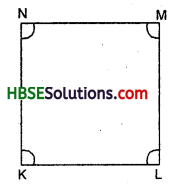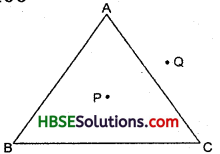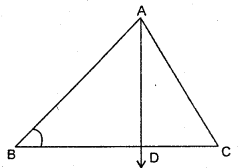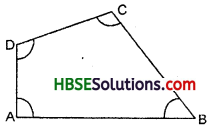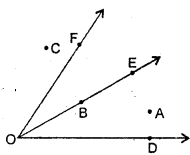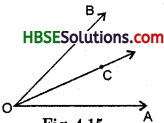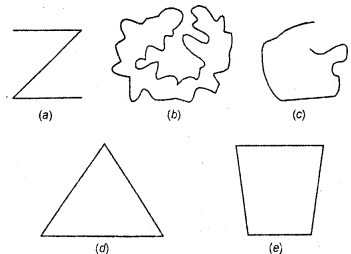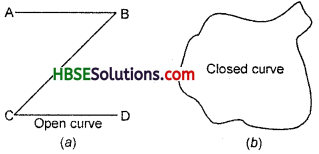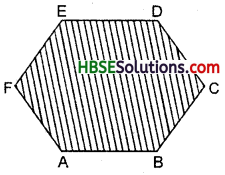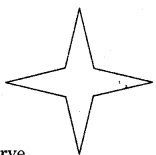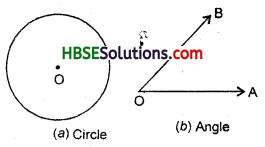HBSE 6th Class Maths Solutions Chapter 3 Playing With Numbers InText Questions
Haryana State Board HBSE 6th Class Maths Solutions Chapter 3 Playing With Numbers InText Questions and Answers.
Haryana Board 6th Class Maths Solutions Chapter 3 Playing With Numbers InText Questions
Try These (Page 58)
Question 1.
Find the possible factors of 45, 30, 36
(i) 45 = 1 × 45
= 3 × 15
= 5 × 9
= 9 × 5
= 15 × 3
= 45 × 1
∴ 1, 3, 5, 9, 15, 45 are all factors of 45.
(ii) 30 = 1 × 30
= 2 × 15
= 3 × 10
= 5 × 6
= 6 × 5
= 10 × 3
= 15 × 2
= 30 × 1
∴ 1, 2, 3, 5, 6, 10, 15, 30 are all factors of 30.
![]()
(iii) 36 = 1 × 36
= 2 × 18
= 3 × 12
= 4 × 9
= 6 × 6
∴ 1, 2, 3, 4, 6, 9, 12, 18, 36 are all factors of 36.
Try These (Page 71)
Question 1.
(i) Find the common factors of: (a) 8, 20, (6) 9, 15
Solution:
(a) Factors of 8 :
8 = 1 × 8
= 2 × 4
∴ Factors of 8 are : 1, 2, 4, 8.
Factors of 20 :
20 = 1 × 20
= 2 x 10
= 4 x 5
∴ Factors of 20 are : 1, 2, 4, 5, 10, 20.
Hence, common factors of 8 and 20 are : 1, 2, 4.
(b) Factors of 9 :
9 = 1 × 9
= 3 × 3
∴ Factors of 9 are : 1, 3, 9.
![]()
Factors of 15 :
15 = 1 × 15
= 3 × 5
∴ Factor’s of 15 are : 1, 3, 5, 15.
Hence, common factors of 9 and 15 are : 1, 3.
Try These
Question 1.
Are (i) 7 and 15, (ii) 12 and 49, (iii) 18 and 23 co-prime numbers ?
Solution:
(i) Factors of 7 = 1 × 7
Factors of 7 are : 1, 7.
Factors of 15 = 1 × 15
Factors of 15 are : 1, 3, 5, 15.
= 3 × 5
∴ Common factor of 7 and 15 is 1 only.
Hence, 7 and 15 are co-prime numbers.
(ii) Factors of 12 :
12 = 1x 12
= 2 × 6
= 3 × 4
∴ Factors of 12 are : 1, 2, 3, 4, 6, 12.
Factors of 49 :
49 = 1 x 49
= 7 × 7
∴ Factors of 49 are : 1, 7, 49.
∴ Common factor of 12 and 49 is 1 only.
Hence, 12 and 49 are co-prime numbers.
(iii) Factors of 18 :
18 = 1x 18
= 2 × 9
= 3 × 6
Factors of 18 are : 1, 2, 3, 6, 9, 18.
Factors of 23 = 1 × 23 .
Factors of 23 are : 1, 23.
∴ Common factor of 18 and 23 is only 1.
Hence, 18 and 23 are co-prime numbers.
Try These
Question 1.
Find the common factors of: (a) . 8, 12, 20, (b) 9, 15, 21.
Solution:
(a) 8 = 1 × 8
= 2 x 4
12 = 1 × 12
= 2 × 6
= 3 × 4
20 = 1 × 20
= 2 × 10
= 4 × 5
Factors of 8 are : 1, 2, 4, 8.
Factors of 12 are : 1, 2, 3, 4, 6, 12.
Factors of 20 are : 1, 2, 4, 5, 10, 20.
∴ Common factors of 8, 12, 20 are : 1, 2, 4.
(b) 9 = 1 × 9
= 3 × 3
15 = 1 × 15
= 3 × 5
21 = 1 × 21
= 3 × 7
Factors of 9 are : 1, 3, 9.
Factors of 15 are : 1, 3, 5, 15.
Factors of 21 are : 1, 3, 7, 21.
∴ Common factors of 9, 15, 21 are : 1, 3.
![]()
Question 5.
Find the common multiples of:
(a) 4 and 6,
(b) 3, 5 and 6.
Solution:
(a) Multiples of 4 are 4, 8, 12, 16, 20, 24, …………….
Multiples of 6 are 6,12,18,24, 30, 36……….
We observe that 12, 24, 36, are multiples of both 4 and 6.
They are called the common multiples of 4 and 6.
(b) Multiples of 3 are : 3, 6, 9, 12, 15; 18, 21, 24, 27, 30,…………….
Multiples of 5 are : 5, 10, 15, 20, 25, 30, 35, 40, …………….
Multiples of 6 are : 6, 12, 18, 24, 30, 36, 42, 48,…………….
∴ Common multiples of 3, 5 and 6 are 30, 60, 90,…………….
Try These (Page 75)
Question 1.
Write the prime factorisations of (i) 16, (ii) 28, (iii) 38.
Solution:
(i) 16 = 2 × 8
= 2 × 2 × 4
= 2 × 2 × 2 × 2

16 = 4 × 4
= 2 × 2 × 4
= 2 × 2 × 2 × 2
In all the above factorisations of 16, we ultimately arrive at only one factorisation 2 × 2 × 2 × 2. In this factorisation the only factor 2 is a prime number. Such a factorisation of a number is called a prime factorisation.
Prime Factorisation Property or The Fundamental Theorem of Arithmetic : “Every number greater than 1 has exactly one prime factorisation.”
(ii) 28 = 2 × 14
= 2 × 2 × 7

In this factorisation the only factors 2 and 7 are prime numbers.
The prime factorisation of 28 is 2 × 2 × 7.
(iii) 38 = 2 × 19
![]()
Here 2 and 19 are both prime numbers
Prime factorisation of 38 is 2 × 19.
![]()
Try These (Page 76)
Question 1.
Write the prime factorisations of (a) 8, (b) 12.
Solution:
(a) 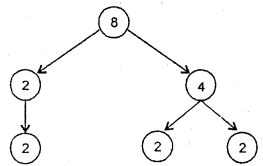
∴ Prime factorisation of 8 is 2 × 2 × 2.
(b)
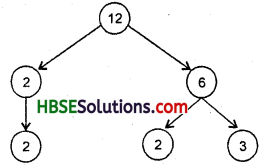
∴ Prime factorisation of 12 is 2 × 2 × 3.
(c)
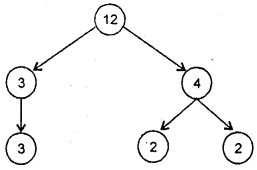
∴ Prime factorisation of 12 is 3 × 2 × 2.
Try These (Page 78)
Question 1.
Find the H.C.F. of
(i) 24 and 36
(ii) 15, 25 and 30
(iii) 8 and, 12
(iv) 12, 16 and 28.
Solution:
(i) 24 = 1 × 24
= 2 × 12 .
= 3 × 8
= 4 × 6
36 = 1 × 36
= 2 × 18
= 3 × 12
= 4 × 9
= 6 × 6
Factors of 24 are 1, 2, 3, 4, 6, 8, 12, 24 Factors of 36 are 1, 2, 3, 4, 6, 9, 12, 18, 36
Common factors of 24 and 36 are 1, 2, 3, 4, 6, 12.
Hence, H.C.F. of 24 and 36 is 12.
Another Method :
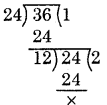
Hence, H.C.F. of 24 and 36 is 12.
![]()
(ii) 15 = 1 × 15
= 3 × 5
25 = 1 × 25
= 5 × 5
30 = 1 × 30
= 2 × 15
= 3 × 10
= 5 × 6
∴ Factors of 15 are 1, 3, 5, 15
Factors of 25 are 1, 5, 25
Factors of 30 are 1, 2, 3, 5, 6, 10, 15, 30
Common factors of 15, 25 and 30 are 1, 5
Hence H.C.F. of 15, 25 and 30 is 5.
Another Method :
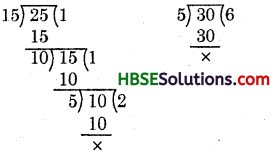
Hence H.C.F. of 15, 25 and 30 is 5.
(iii) 8 = 1 × 8
= 2 × 4
12 = 1 × 12
= 2 × 6
= 3 × 4
∴ Factors of 8 are 1, 2, 4, 8
Factors of 12 are 1, 2, 3, 4, 6, 12
Common factors of 8 and 12 are 1, 2, 4
Hence, H.C.F. of 8 and 12 is 4.
Another Method :
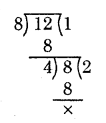
Hence, H.C.F. of 8 and 12 is 4.
(iv) 12 = 1 × 12
= 2 × 6
= 3 × 4
16 = 1 × 16
= 2 × 8
= 4 × 4
28 = 1 × 28
= 2 × 14
= 4 × 7
∴ Factors of 12 are 1, 2, 3, 4, 6, 12
Factors of 16 are 1, 2, 4, 8, 16
Factors of 28 are 1, 2, 4, 7, 14, 28
Common factors of 12, 16 and 28 are 1, 2, 4 .
Hence, H.C.F. of 12, 16 and 28 is 4.
Another Method :

Hence, H.C.F. of 12, 16 and 28 is 4.
Try These (Page 58)
Question 1.
What will be the LCM of: (i) 8 and 12 ? (ii) 4 and 9 ? (iii) 6 and 9 ?
Solution:
(i) Multiples of 8 are : 8, 16, 24, 32, 40, 48, …………..
Multiples of 12 are : 12, 24, 36, 48, 60, 72, ………………
Common multiples of 8 and 12 are : 24, 48, ………………
L.C.M. of 8 and 12 is 24.
Another Method:
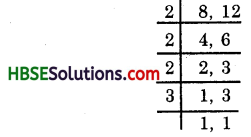
(ii) Multiples of 4 are : 4, 8, 12, 16, 20,24, 28, 32, 36, ………………….
Multiples of 9 are : 9, 18, 27, 36, 45, 54, 63, 72, ………………….
Common multiples of 4 and 9 are : 36, 72, ………………….
∴ L.C.M. of 4 and 9 is 36.
![]()
Another method :
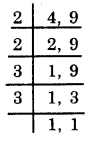
∴ L.C.M. of 4 and 9 = 2 × 2 × 3 × 3 = 36.
(iii) Multiples of 6 are : 6, 12, 18, 24, 30, 36 , ………………..
Multiples of 9 are : 9, 18, 27, 36, 45, 54, ………………..
Common multiples of 6 and 9 are : 18, 36, ………………..
L.C.M. of 8 and 12 = 2 × 2 × 2 × 3 = 24.
(iii) Multiples of 4 are : 4, 8, 12, 16, 20, 24, 28, 32, 36,
Multiples of 9 are : 9, 18, 27, 36, 45, 54, 63, 72f
Common multiples of 4 and 9 are : 36, 72,
∴ L.C.M. of 6 and 9 = 18.
Another method :

∴ L.C.M. of 6 and 9 = = 2 × 3 × 3 = 18.
HBSE 6th Class Maths Solutions Chapter 3 Playing With Numbers InText Questions Read More »

